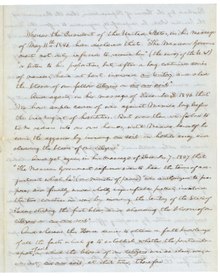| ||
|---|---|---|
|
Personal Political
16th President of the United States First term Second term Presidential elections Speeches and works
Assassination and legacy  |
||
| U.S. congressional opposition to American involvement in wars and interventions |
|---|
| 1812 North America |
| House Federalists’ Address |
| 1847 Mexican–American War |
| Spot Resolutions |
| 1917 World War I |
| Filibuster of the Armed Ship Bill |
| 1935–1939 |
| Neutrality Acts |
| 1935–1940 |
| Ludlow Amendment |
| 1970 Vietnam |
| McGovern–Hatfield Amendment |
| 1970 Southeast Asia |
| Cooper–Church Amendment |
| 1971 Vietnam |
| Repeal of Tonkin Gulf Resolution |
| 1973 Southeast Asia |
| Case–Church Amendment |
| 1973 |
| War Powers Resolution |
| 1974 |
| Hughes–Ryan Amendment |
| 1976 Angola |
| Clark Amendment |
| 1982 Nicaragua |
| Boland Amendment |
| 2007 Iraq |
| House Concurrent Resolution 63 |
| 2011 Libyan War |
| House Joint Resolution 68 |
| 2013 Syrian Civil War |
| Syria Resolution |
| 2018–2019 Yemen |
| Yemen War Powers Resolution |
The spot resolutions were offered in the United States House of Representatives on 22 December 1847 by future President Abraham Lincoln, then a Whig representative from Illinois. The resolutions requested President James K. Polk to provide Congress with the exact location (the "spot") upon which blood was spilled on American soil, as Polk had claimed in 1846 when asking Congress to declare war on Mexico. Lincoln's persistence in pushing his "spot resolutions" led some to begin referring to him as "spotty Lincoln." Lincoln's resolutions were a direct challenge to the validity of the president's words, and representative of an ongoing political power struggle between Whigs and Democrats.
Eight resolutions sought specific information. The first: "whether the spot on which the blood of our citizens was shed, as in his messages declared, was or was not within the territory of Spain, at least after the treaty of 1819, until the Mexican revolution." The second: "whether that spot is or is not within the territory which was wrested from Spain by the revolutionary Government of Mexico." The other six resolutions extended the analysis to determine whether the territory on which the casualties occurred was ever under the government or laws of Texas or of the United States. The House of Representatives never acted on Lincoln's resolutions, but they demonstrated the Whig reluctance to accept President Polk's grounds to begin the war.

According to Lincoln biographer David Herbert Donald, "nobody paid much attention to his resolutions, which the House neither debated nor adopted". Many Democrats regarded the resolutions as unpatriotic; some Whigs cautioned that criticism of the war would hurt the Whigs politically. Lincoln, however, was not speaking out against the war itself, but rather against Polk's conduct of it. In fact, the Whigs would later nominate Zachary Taylor (a hero of the war) as their candidate, whom Lincoln supported.
The location where the initial bloodshed (known as the Thornton Affair) occurred in April 1846 is located in present-day Cameron County, Texas, just north of the Rio Grande which represented the American claim for Texas's boundary with Mexico (as well as the current international border). The Mexican claim set the boundary at the Nueces River, considerably further north.
References
- Gerleman, David J. (Winter 2017). "Representative Lincoln at Work: Reconstructing a Legislative Career from Original Archival Documents". The Capitol Dome. 54 (2). The United States Capitol Historical Society: 33–46.
- Fisher, Louis (August 18, 2009). "The Mexican War and Lincoln's "Spot Resolutions"" (PDF). The Law Library of Congress. Retrieved 14 January 2016.
- Abraham Lincoln, Spot Resolutions in the United States House of Representatives, December 22, 1847, National Archives Building, RG 233, Entry 362: Thirtieth Congress, 1847-1849, Records of Legislative Proceedings, Bills and Resolutions Originating in the House, 1847-1849
- Donald, David Herbert (2011). Lincoln. New York, NY: Simon and Schuster. p. 124. ISBN 978-0-684-80846-8.
External links
- Handwritten copy of the resolutions
- Text of the resolutions
- https://www.loc.gov/law/help/usconlaw/pdf/Mexican.war.pdf
